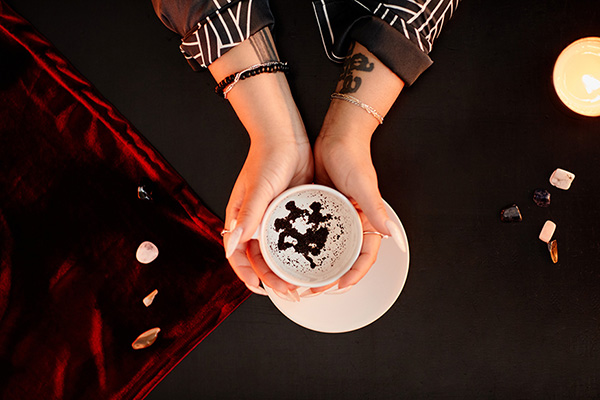How To Do A Tea-Leaf Reading
 When I do a teacup reading, I let my mind to run free as I interpret the symbols in the tea leaves for the client. There are standard traditional guidelines as to what different shapes may symbolize, but I prefer to let my intuition do the talking.
When I do a teacup reading, I let my mind to run free as I interpret the symbols in the tea leaves for the client. There are standard traditional guidelines as to what different shapes may symbolize, but I prefer to let my intuition do the talking.
Interpretation of the tea leaves is subjective, and there is no one right way to do it. Different readers will interpret the same patterns differently.
However, there are some common symbols one will often find in the bottom of the cup include animals, human faces, and all kinds of everyday objects. Symbols grouped together can create a theme, and sometimes the tea leaves spell out letters of the alphabet or numbers.
Tea-leaf reading is also known as tasseography, tasseomancy or tassology. Tasseography is also done by reading wine sediments and coffee grounds. This divination practice possibly originated in China, where tea was first cultivated, and may have evolved from the Chinese traditions of divining the patterns left by the dregs of wine in a cup, as well as the patterns created by the smoke from incense sticks.
Tea itself was first introduced to Europe in the 17th century and thus tea-leaf reading spread to other parts of the world. Among the first Europeans to embrace the practice were the traveling Romani people, who sometimes offered is as a door-to-door service. Tea-leaf reading also became popular in Victorian times as a parlor game.
Like Tarot reading or scrying a crystal ball, tea-leaf reading is a divination method for accessing the universal consciousness via the subconscious mind. Slowing down the rational, analytical mind allows us to focus on our intuition to receive divine guidance.
While the tools you need are perhaps not as extensive or fancy as other divination methods, tasseography has the potential to be an extremely expansive and far-reaching practice with its messages and symbols ~ Lexi Hikari
The typical procedure for doing a teal-leaf readings is as follows:
Environment: A quiet, peaceful environment is best to ensure concentration and the reader’s ability to carefully interpret the tea-leaf patterns.
Equipment: A simple cup and saucer will do, but there are cup and saucer sets available on the market that are specifically designed for reading tea leaves. These sets include sets decorated with Tarot cards, esoteric symbols, or the signs of the zodiac.
Ingredients: All that is needed is about a teaspoon of loose tea steeped in some hot water. Tea from a tea bag is too fine to decipher symbols.
Procedure: Begin by asking the client to focus on their question or intention. The client should sit close to the reader. Scoop the loose tea into the cup and add hot water or pour a cup of tea for the client, leaving the leaves unstrained. The client then slowly drinks the tea, leaving a small amount at the bottom of the cup. The longer the client can hold the cup and focus on the leaves, the more accurate the reading will be.
The client is then asked to swirl the residue in the cup three times in a clockwise direction. The cup is then turned upside down onto the saucer, allowing the leftover tea to drain away. Now interpret the patterns and shapes formed by the leaves.
When tea becomes ritual, it takes its place at the heart of our ability to see greatness in small things. Where is beauty to be found? In great things that, like everything else, are doomed to die, or in small things that aspire to nothing, yet know how to set a jewel of infinity in a single moment ~ Muriel Barbery
Interpretations: Weak tea indicates a friendship coming to an end. Strong tea indicates a new friendship. Sadness in the client’s future is indicated if the tea does not drain. Bubbles rising to the surface of the tea may indicate a kiss or that money is on the way. Any spillage is considered lucky by some readers.
Stems in leaf images can represent people, and the angle of the stems can reveal information about a person, including whether they are untrustworthy (angled sideways) or very angry (stems crossed). A stem or stalk floating to the surface indicates a female or male visitor.
Tea-leaf symbols that disappear quickly after being read suggest that they relate to matters that are no longer of great importance to the sitter. The clarity and size of an image should also be considered. A thick tea-leaf symbol means that the effect will be strong in the life of the client. For the timing of an event, the closer the symbol is to the edge of the cup, the sooner it will happen.
When the tea-leaf reading is concluded, folklore suggests that throwing them on the ground can ward off evil spirits.
|
|

Leave a Reply